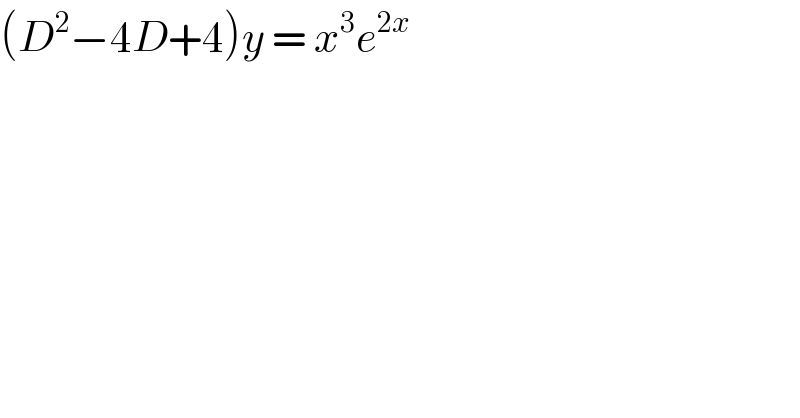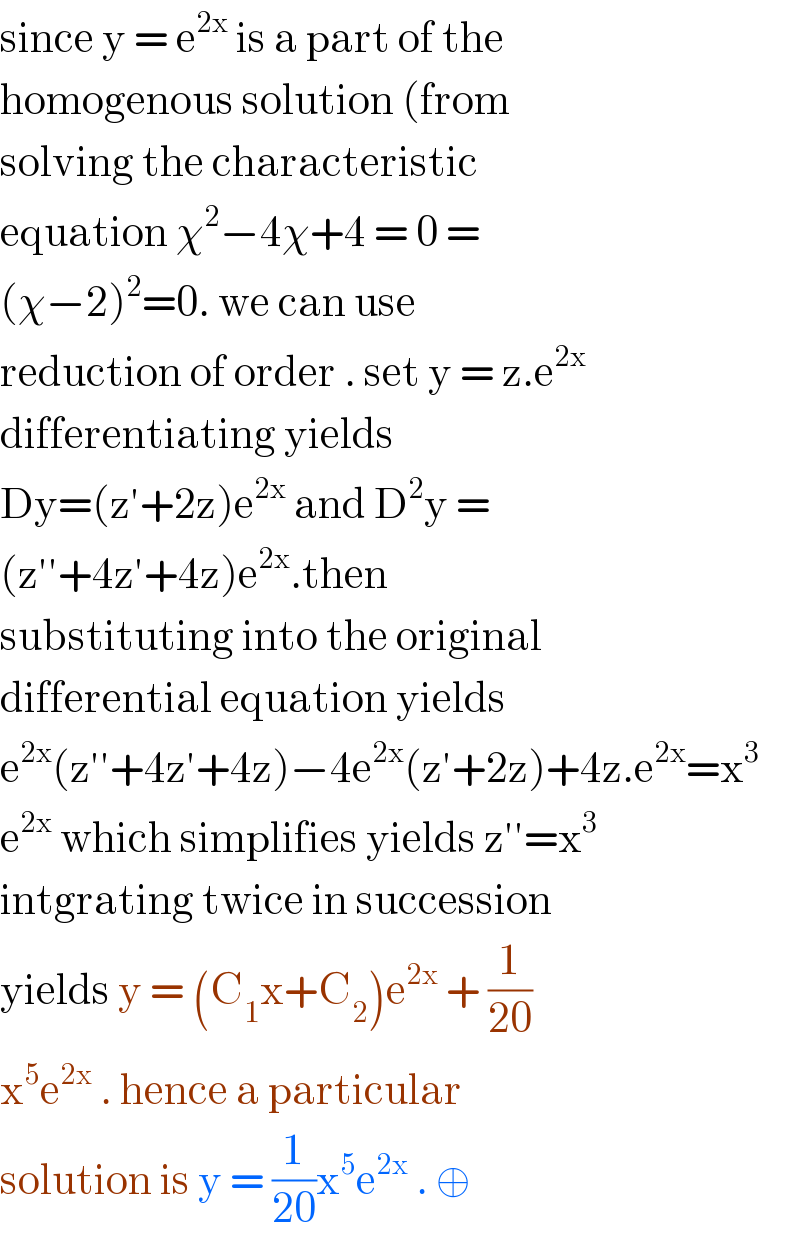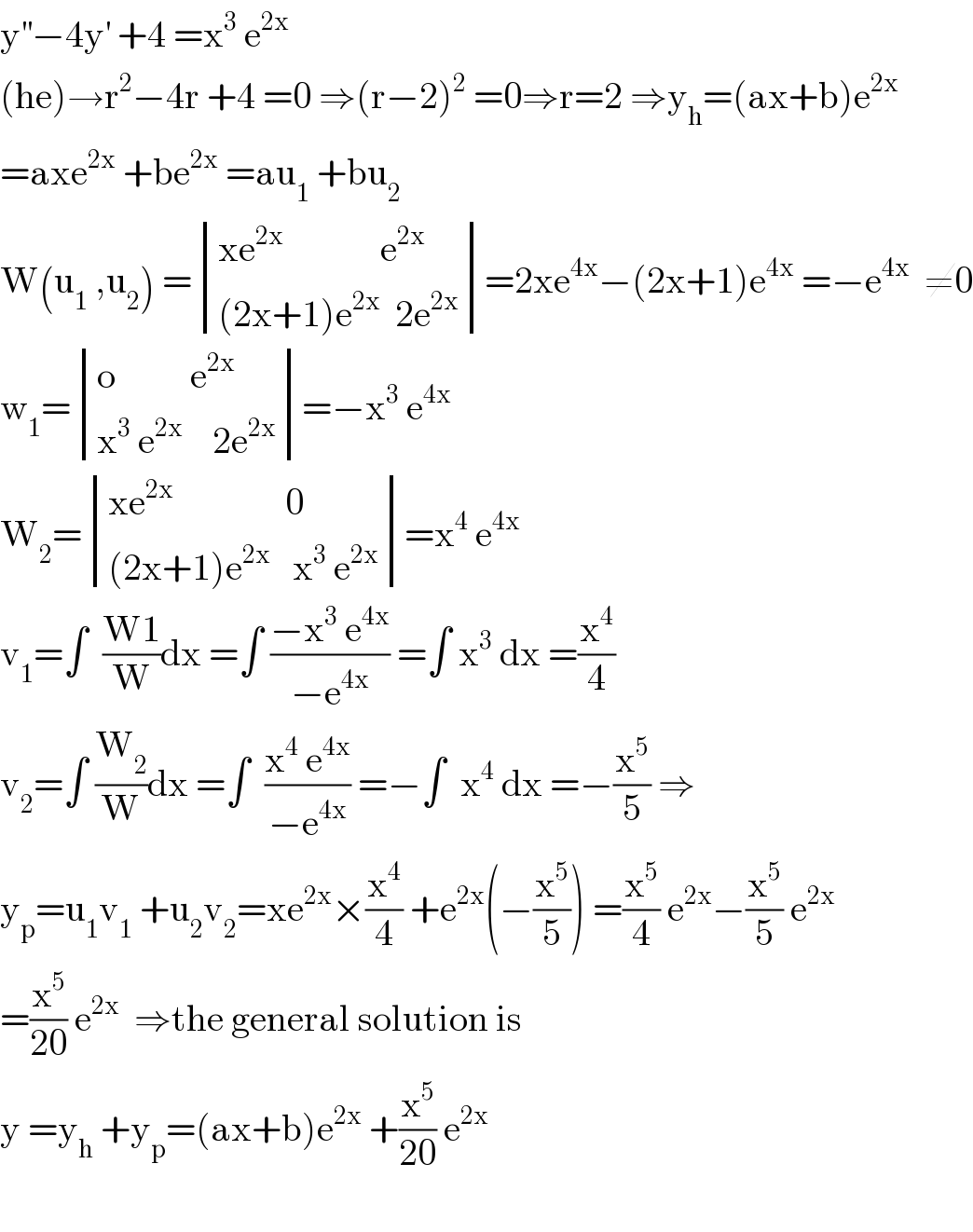Question Number 103009 by bobhans last updated on 12/Jul/20

$$\left({D}^{\mathrm{2}} −\mathrm{4}{D}+\mathrm{4}\right){y}\:=\:{x}^{\mathrm{3}} {e}^{\mathrm{2}{x}} \: \\ $$
Answered by bramlex last updated on 12/Jul/20

$$\mathrm{since}\:\mathrm{y}\:=\:\mathrm{e}^{\mathrm{2x}} \:\mathrm{is}\:\mathrm{a}\:\mathrm{part}\:\mathrm{of}\:\mathrm{the} \\ $$$$\mathrm{homogenous}\:\mathrm{solution}\:\left(\mathrm{from}\right. \\ $$$$\mathrm{solving}\:\mathrm{the}\:\mathrm{characteristic} \\ $$$$\mathrm{equation}\:\chi^{\mathrm{2}} −\mathrm{4}\chi+\mathrm{4}\:=\:\mathrm{0}\:= \\ $$$$\left(\chi−\mathrm{2}\right)^{\mathrm{2}} =\mathrm{0}.\:\mathrm{we}\:\mathrm{can}\:\mathrm{use} \\ $$$$\mathrm{reduction}\:\mathrm{of}\:\mathrm{order}\:.\:\mathrm{set}\:\mathrm{y}\:=\:\mathrm{z}.\mathrm{e}^{\mathrm{2x}} \\ $$$$\mathrm{differentiating}\:\mathrm{yields} \\ $$$$\mathrm{Dy}=\left(\mathrm{z}'+\mathrm{2z}\right)\mathrm{e}^{\mathrm{2x}} \:\mathrm{and}\:\mathrm{D}^{\mathrm{2}} \mathrm{y}\:= \\ $$$$\left(\mathrm{z}''+\mathrm{4z}'+\mathrm{4z}\right)\mathrm{e}^{\mathrm{2x}} .\mathrm{then} \\ $$$$\mathrm{substituting}\:\mathrm{into}\:\mathrm{the}\:\mathrm{original} \\ $$$$\mathrm{differential}\:\mathrm{equation}\:\mathrm{yields}\: \\ $$$$\mathrm{e}^{\mathrm{2x}} \left(\mathrm{z}''+\mathrm{4z}'+\mathrm{4z}\right)−\mathrm{4e}^{\mathrm{2x}} \left(\mathrm{z}'+\mathrm{2z}\right)+\mathrm{4z}.\mathrm{e}^{\mathrm{2x}} =\mathrm{x}^{\mathrm{3}} \\ $$$$\mathrm{e}^{\mathrm{2x}} \:\mathrm{which}\:\mathrm{simplifies}\:\mathrm{yields}\:\mathrm{z}''=\mathrm{x}^{\mathrm{3}} \\ $$$$\mathrm{intgrating}\:\mathrm{twice}\:\mathrm{in}\:\mathrm{succession} \\ $$$$\mathrm{yields}\:\mathrm{y}\:=\:\left(\mathrm{C}_{\mathrm{1}} \mathrm{x}+\mathrm{C}_{\mathrm{2}} \right)\mathrm{e}^{\mathrm{2x}} \:+\:\frac{\mathrm{1}}{\mathrm{20}} \\ $$$$\mathrm{x}^{\mathrm{5}} \mathrm{e}^{\mathrm{2x}} \:.\:\mathrm{hence}\:\mathrm{a}\:\mathrm{particular} \\ $$$$\mathrm{solution}\:\mathrm{is}\:\mathrm{y}\:=\:\frac{\mathrm{1}}{\mathrm{20}}\mathrm{x}^{\mathrm{5}} \mathrm{e}^{\mathrm{2x}} \:.\:\oplus \\ $$
Commented by bobhans last updated on 12/Jul/20

$${yes}… \\ $$
Answered by mathmax by abdo last updated on 12/Jul/20

$$\mathrm{y}^{''} −\mathrm{4y}^{'} \:+\mathrm{4}\:=\mathrm{x}^{\mathrm{3}} \:\mathrm{e}^{\mathrm{2x}} \\ $$$$\left(\mathrm{he}\right)\rightarrow\mathrm{r}^{\mathrm{2}} −\mathrm{4r}\:+\mathrm{4}\:=\mathrm{0}\:\Rightarrow\left(\mathrm{r}−\mathrm{2}\right)^{\mathrm{2}} \:=\mathrm{0}\Rightarrow\mathrm{r}=\mathrm{2}\:\Rightarrow\mathrm{y}_{\mathrm{h}} =\left(\mathrm{ax}+\mathrm{b}\right)\mathrm{e}^{\mathrm{2x}} \\ $$$$=\mathrm{axe}^{\mathrm{2x}} \:+\mathrm{be}^{\mathrm{2x}} \:=\mathrm{au}_{\mathrm{1}} \:+\mathrm{bu}_{\mathrm{2}} \\ $$$$\mathrm{W}\left(\mathrm{u}_{\mathrm{1}} \:,\mathrm{u}_{\mathrm{2}} \right)\:=\begin{vmatrix}{\mathrm{xe}^{\mathrm{2x}\:\:} \:\:\:\:\:\:\:\:\:\:\:\:\mathrm{e}^{\mathrm{2x}} }\\{\left(\mathrm{2x}+\mathrm{1}\right)\mathrm{e}^{\mathrm{2x}} \:\:\mathrm{2e}^{\mathrm{2x}} }\end{vmatrix}=\mathrm{2xe}^{\mathrm{4x}} −\left(\mathrm{2x}+\mathrm{1}\right)\mathrm{e}^{\mathrm{4x}} \:=−\mathrm{e}^{\mathrm{4x}} \:\:\neq\mathrm{0} \\ $$$$\mathrm{w}_{\mathrm{1}} =\begin{vmatrix}{\mathrm{o}\:\:\:\:\:\:\:\:\:\:\mathrm{e}^{\mathrm{2x}} }\\{\mathrm{x}^{\mathrm{3}} \:\mathrm{e}^{\mathrm{2x}} \:\:\:\:\mathrm{2e}^{\mathrm{2x}} }\end{vmatrix}=−\mathrm{x}^{\mathrm{3}} \:\mathrm{e}^{\mathrm{4x}} \\ $$$$\mathrm{W}_{\mathrm{2}} =\begin{vmatrix}{\mathrm{xe}^{\mathrm{2x}} \:\:\:\:\:\:\:\:\:\:\:\:\:\:\:\mathrm{0}}\\{\left(\mathrm{2x}+\mathrm{1}\right)\mathrm{e}^{\mathrm{2x}} \:\:\:\mathrm{x}^{\mathrm{3}} \:\mathrm{e}^{\mathrm{2x}} }\end{vmatrix}=\mathrm{x}^{\mathrm{4}} \:\mathrm{e}^{\mathrm{4x}} \\ $$$$\mathrm{v}_{\mathrm{1}} =\int\:\:\frac{\mathrm{W1}}{\mathrm{W}}\mathrm{dx}\:=\int\:\frac{−\mathrm{x}^{\mathrm{3}} \:\mathrm{e}^{\mathrm{4x}} }{−\mathrm{e}^{\mathrm{4x}} }\:=\int\:\mathrm{x}^{\mathrm{3}} \:\mathrm{dx}\:=\frac{\mathrm{x}^{\mathrm{4}} }{\mathrm{4}} \\ $$$$\mathrm{v}_{\mathrm{2}} =\int\:\frac{\mathrm{W}_{\mathrm{2}} }{\mathrm{W}}\mathrm{dx}\:=\int\:\:\frac{\mathrm{x}^{\mathrm{4}} \:\mathrm{e}^{\mathrm{4x}} }{−\mathrm{e}^{\mathrm{4x}} }\:=−\int\:\:\mathrm{x}^{\mathrm{4}} \:\mathrm{dx}\:=−\frac{\mathrm{x}^{\mathrm{5}} }{\mathrm{5}}\:\Rightarrow \\ $$$$\mathrm{y}_{\mathrm{p}} =\mathrm{u}_{\mathrm{1}} \mathrm{v}_{\mathrm{1}} \:+\mathrm{u}_{\mathrm{2}} \mathrm{v}_{\mathrm{2}} =\mathrm{xe}^{\mathrm{2x}} ×\frac{\mathrm{x}^{\mathrm{4}} }{\mathrm{4}}\:+\mathrm{e}^{\mathrm{2x}} \left(−\frac{\mathrm{x}^{\mathrm{5}} }{\mathrm{5}}\right)\:=\frac{\mathrm{x}^{\mathrm{5}} }{\mathrm{4}}\:\mathrm{e}^{\mathrm{2x}} −\frac{\mathrm{x}^{\mathrm{5}} }{\mathrm{5}}\:\mathrm{e}^{\mathrm{2x}} \\ $$$$=\frac{\mathrm{x}^{\mathrm{5}} }{\mathrm{20}}\:\mathrm{e}^{\mathrm{2x}} \:\:\Rightarrow\mathrm{the}\:\mathrm{general}\:\mathrm{solution}\:\mathrm{is} \\ $$$$\mathrm{y}\:=\mathrm{y}_{\mathrm{h}} \:+\mathrm{y}_{\mathrm{p}} =\left(\mathrm{ax}+\mathrm{b}\right)\mathrm{e}^{\mathrm{2x}} \:+\frac{\mathrm{x}^{\mathrm{5}} }{\mathrm{20}}\:\mathrm{e}^{\mathrm{2x}} \\ $$$$ \\ $$
Commented by bemath last updated on 12/Jul/20

$${sir}\:{Abdo}\:\&\:{sir}\:{Bramlex}\:{coll}\: \\ $$
Commented by mathmax by abdo last updated on 13/Jul/20

$$\mathrm{thanks}\:\mathrm{sir} \\ $$
